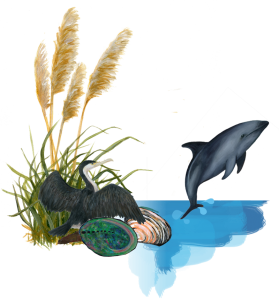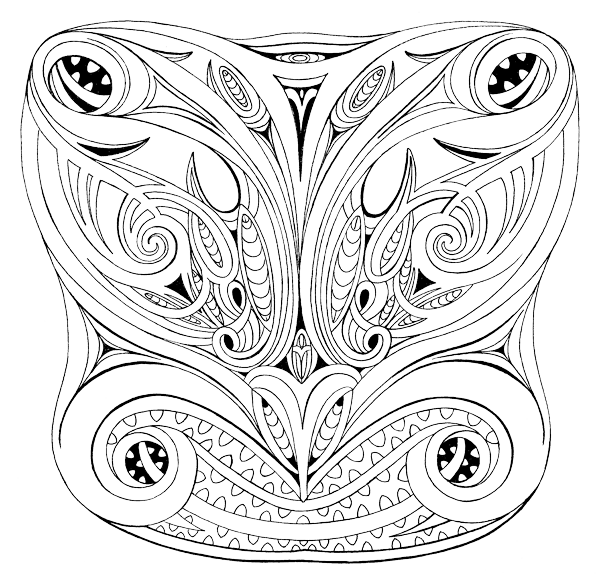
Hinemoana, female aspect of the sea.
Jamie, Alexis, Dom and I were delighted to be sponsored by Toimata Foundation to join delegates from as far afield as the Far North, Wanganui, Hutt City, Coromandel and Auckland for the amazing presentations and fieldtrips on the Murihiku Coastal Treasures Conference. Environment Southland and DoC staff looked after us extremely well, particularly in the face of the stringent hygiene and social distancing requirements that Covid-19 determined.
Having just worked through our Bronze Enviroschools Reflection with Megan, the Regional Coordinator for Enviroschools in Southland, on Monday afternoon, we were still riding the wave of positivity from the realisation that we had made a good start on our sustainability learning journey, and we were ready to be inspired about potential environmental directions that we could follow for the Silver stage of this Enviroschools journey.
One of the stories we shared about our current learning for the Bronze reflection was how our Year 10 students and teachers have been involved in a sustainability project in conjunction with Creatives (an artist and a poet) from the Riverton Arts Centre working on clearing the built up driftwood from the beach, writing poetry and consolidating connections with Riverton – Aparima. They then designed sculptures on a similar theme which have since been installed along our Wellbeing Walkway.
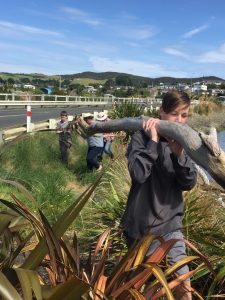
The year 10 students are clearing the beach of driftwood that built up following the floods we had in February.

The students wrote poems about their connection with Riverton-Aparima and then designed sculptures on a similar theme, made from driftwood and ‘found’ objects, which have been installed along our Wellbeing Walkway.
The Murihiku Coastal Treasures Conference definitely provided us with a multitude of possibilities. Day 1 was based in the Bill Richardson Transport Museum, reminding us that one person’s passion for restoration can be hugely infectious. The twenty sustainability professionals and volunteers who presented on their area of specialty were equally passionate and infectious – in a good way! Nick Ward horrified us by explaining the widespread degradation of Southland estuaries and lakes, showing that a holistic ecosystem-wide response was desperately needed. Keryn Roberts described how coastal dune lakes could be restored gradually with careful management, and Dune Restoration coordinators from Coromandel, Waikato West and East explained the processes they had followed, under the mentorship of scientist Jim Dahm, to manage the threats of pest plants and erosion from the sea. Joyce Kolk and Ben Knight showed how we can all help by systematically cleaning-up the waste washed onto our beaches, something which Aparima College has already signed up for. We left the Museum with brains bursting with new information but also feeling reassured that so many capable people are so invested in protecting and restoring coastal ecosystems of Aotearoa.
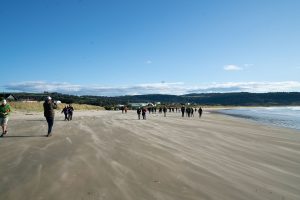
Delegates explore Curio Bay (photo by: Dom Riddell)
Day 2 involved jumping on a bus for a field trip to Curio Bay in the Catlins. En route we had fascinating, and at times hilarious, commentary from Lloyd Esler, Paul Duffy and Jessie Bythell on the botanical, cultural, historical and political environment that we were passing through. The Curioscape film was inspiring, especially as Dom is in the process of making an enviro-film depicting our Creatives project at College. Slope Point revealed a hidden jewel in the shape of a dune lake and Waipapa Point rewarded us with an entertaining sea lion and a blustery walk from the lighthouse across farmland which is currently being invaded by dunes.
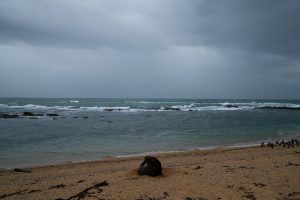
Wildlife including a sea lion at Slope Point. (photo by: Dom Riddell)
Discussions along the way showed that people were really happy to share their successes and frustrations on various aspects of looking after coastal environments, from the eco-sourcing and propagating of seeds through to the importance of inclusivity and a long-term perspective when making any changes to the environment.
Day 3’s field trip to Waituna Lagoon was equally amazing. As the oldest and largest Ramsar site (Wetlands of International Importance) in New Zealand , Waituna has a wealth of natural resources and dedicated Landcare groups who are looking after them. Murray Waghorn described his lifetime’s attachment to this beautiful place and Katrina Robertson detailed the complex relationship between farming and the environment.

Moody Waipapa beach (photo by: Dom Riddell)
From there we returned to Invercargill, visiting the New River Estuary, which we saw with fresh eyes, having heard from Gavin Gilder about the reclamation of the land on which the airport is built and the fragility and expense of flood mitigation efforts. Familiar Oreti Beach was also fun to visit with a bunch of interested environmentalists and we experienced a fresh appreciation for the huge resource that we have in Sandy Point.

Waipapa Lighthouse (photo by: Dom Riddell)
Our final session at the Mauritangi Scout Den gave us the opportunity to hear first-hand about pest eradication on Stewart Island, and to end on a positive note with Richard Kyte describing the power of story to connect individuals and groups with their local environment.
Our big take-aways from this Conference:
- Working together towards a common environmental goal is important, as well as listening to a range of perspectives and aiming for a holistic response which values both traditional knowledge and uses modern technology and equipment.
- The best place to start is just to start, ie. to do something small. For example, Tui Lewis from Hutt City enthused Alexis to document the historic buildings in Riverton ‘time-team’ style, in order to collect 2020 data that can be used for comparison, and we have gained permission for her to do this as an Elective option.
In conclusion, we found the Conference delegates and organisers generous with their time and knowledge. We have a list of about 12 projects that we want to develop over the next year or so, some using the mentorship and capability of these awesome people. As Year 13 Enviroleaders, Jamie, Alexis and Dom feel excited to share the ideas we have heard from the last three days and, as a teacher, I feel enthused and buoyant about our Enviroschools projects. Thank you so much for providing the opportunity.
Banner Photo: Aparima College Murihiku Coastal Treasures Conference delegates Jamie, Alexis and Dom.
